#considering that both characters are of the “wrestles with monsters” archetype they both make for compelling reading imo
Text
The fantastical HBO series imagines white supremacists as literal monsters but fails to make its Black heroes as compelling.
HANNAH GIORGISAUGUST 14, 2020
Like many young people, the protagonist of the 2016 novel Lovecraft Country devours entertainment that his father finds foolish and reprehensible. Atticus loves reading science fiction, fantasy, and horror—genres that, as his dad points out, are dominated by white authors and full of racist stereotypes. The tension inherent in Atticus’s fondness for such writers drives much of Lovecraft Country, which is set in the 1950s. And no author looms larger in Matt Ruff’s book, or in the HBO adaptation that premieres Sunday, than the one for whom it is named. Early in the novel, Atticus recalls a night when his father handed him a poem by H. P. Lovecraft called “On the Creation of Niggers,” which describes Black people as “semi-humans” and “beasts.” The verses are a departure from the late author’s hugely influential brand of cosmic horror and a succinct illustration of Lovecraft’s bigotry.
But Lovecraft Country inverts the xenophobic preoccupations of its titular author, suggesting that white racists—and not Black people—are the real beasts. Considering the long history of Black people being depicted as monsters throughout American cinema, especially in sci-fi and horror, this is an admirable premise that is often rendered vividly. When terrifying creatures appear on-screen in the HBO series, the threat they pose to the story’s heroes feels urgent and visceral. Like the novel, the show follows Atticus (played by Jonathan Majors), a young Korean War veteran on a quest to find his father, Montrose (Michael K. Williams), who disappeared en route to Massachusetts. Setting off from Chicago, Atticus is joined by his Uncle George (Courtney B. Vance), as well as his childhood friend Letitia (Jurnee Smollett), whom the series promotes to love interest. Along the way, the three face dangers both mundane and otherworldly, from encounters with Jim Crow–era racism to battles with bloodthirsty behemoths resembling the shape-shifting “shoggoths” of Lovecraftian lore.
Read: ‘Political correctness’ won’t ruin Lovecraft’s legacy
But although the book dramatizes the wickedness of white supremacy without losing its Black characters’ interiority, the adaptation bears down on the cartoonish villainy of its white antagonists. Again and again, Lovecraft Country reminds viewers that ordinary racists can be transformed into something even more grotesque. In many cases, these sequences are literal: In the first episode, a white sheriff stops the central trio to inform them that they’re driving through a “sundown county,” a reference to the segregated towns where Black people seen after dark were often killed. After humiliating Atticus, the slur-wielding sheriff and two other white officers force all three Black characters to the ground and accuse them of robberies. That’s when monsters emerge from the forest, ripping one officer’s arm clean off his body and later turning the sheriff into a beast just like them. The sequence is satisfyingly pulpy, with dynamic pacing that builds legitimate intrigue and sometimes even dread.
It is unclear what animates Lovecraft Country’s main Black characters—Atticus, George, and Letitia—when they’re not fighting racists, whether man or beast. (Elizabeth Morris / HBO)
The HBO series, which was written and developed by Misha Green, has received heaps ofearly praise from critics, many of whom cite itsusage of horror to dramatize the ugliness of racism. But Lovecraft Country stops short of deploying horror to convey new insights about the perils of white supremacy. Across the five episodes made available to critics, the show spends so much time focusing on its white characters’ near-comic monstrousness that it undercuts the development of its Black leads. It’s clear that the series thinks racism is evil, more so than even Lovecraft’s shoggoths. Through a convoluted subplot about a cult-like family of bigots known as the Braithwhites, the show also makes clear how intimately racism can figure into Black people’s lives. But halfway through the series, I’m still left wondering who Atticus, George, and especially Letitia (a classic “Strong Female Character” archetype) really are. What animates Lovecraft Country’s Black characters when they’re not fighting racists, whether man or beast?
It’s not enough to ask that viewers root for Atticus, George, and Leti just because racists are bad. For Lovecraft Country to be a series that successfully melds genre tropes and social commentary, the show needs its characters to be compelling even absent the threat of a sheriff’s loaded shotgun or a monster’s bloody jowls. As is, the show inadvertently simplifies the realities of white supremacy with its monster allegory, while treating the Black cast less as characters in their own right and more as vehicles for a sweeping critique of American racism.
To be fair, some of this disconnect isn’t necessarily the fault of the series. The dystopiandynamics of the current national reckoning on racism can make any supernatural depiction of bigotry feel underwhelming. Though white supremacy was certainly a danger at the time of the book’s release, daily life without a deadly pandemic and a virulently racist president felt altogether less eerie. When Ruff, who is white, published Lovecraft Country in February 2016, the country was in the twilight of the Obama years, only 18 months removed from the start of protests against police violence in Ferguson, Missouri.
The book also preceded a series of what one might call “racial-justice entertainment.” In the time since Lovecraft Country’s publication, an entire cottage industry of Black Lives Matter–adjacent books and productions have captured audiences’ attention by wrestling with the threats that institutional racism poses to Black life in America. These works have spanned genres and media—there are young-adult novels such as The Hate U Give and Dear Martin, police dramas such as Blindspotting and BlacKkKlansman, and period pieces such as Green’s TV series Underground.
The recent resurgence of Black horror and speculative fiction offers perhaps the most useful lessons for Lovecraft Country and future productions like it. Most obvious, Get Out, which was written and directed by the Lovecraft Country producer Jordan Peele, was an effective and entertaining film not just because of the brutality its protagonist faced, or even because of its allusions to contemporary and historical racism. The “monsters” hunting the film’s hero, Chris (Daniel Kaluuya), weren’t pure evil. Unlike Lovecraft Country’s Braithwhite family, who are styled to look so Aryan that they nearly resemble demonic elves, the Armitages concealed their dark predilections under the veneer of NPR-loving, Obama-voting liberal niceness.
Read: What made that hypnosis scene in ‘Get Out’ so terrifying
Chris, for his part, didn’t relate to other Black people only when targeted by white violence, nor was he sympathetic only when faced with the threat of a bodily takeover. When police lights flash on Chris at the end of the film—as when the Black hero of George Romero’s 1968 classic Night of the Living Dead is killed by the white mob in that film’s final scene—the intractability and weight of racism are communicated without relying on horror conceits. Even Atlanta, Donald Glover’s Twin Peaks–esque FX series, toys with the supernatural and the surreal to underscore points about race made in its quieter moments. The mystical elements heighten and complicate existing dread; they alone don’t create it.
Racial horror is most effective when the central characters feel rich and fleshed-out, when audiences are invested in them not just out of implied moral obligation. For Lovecraft Countryto simply flip the usual script with new creatures, then, isn’t enough. The series needs to double down on its most spirited scenes, such as when it navigates a beautifully staged 1950s Chicago, where a broad range of Black characters populate the screen and make the story feel most alive. Spending time with Atticus, George, and Leti in more earthly realms—where the relatable challenges they face add as much to the story as the ravenous aliens do—would make the dangers lurking in Lovecraft Country feel more real, monsters and all.
We want to hear what you think about this article. Submit a letter to the editor or write to [email protected].
Hannah Giorgis is a staff writer at The Atlantic, where she covers culture
0 notes
Text
Summer 2017 Anime Overview: My Hero Academia Season 2 and KiraKira Precure a la Mode
We return to our look at the summer 2017 anime. I’ve been reviewing the seven anime I watched from worst to best. Previously I talked about the two weakest anime I watched and an anime that was kind of mixed and middling. Now we’re going to talk about too anime I watched that I consider to be Very Good and would overall recommend (with some warnings and caveats regarding some stuff for one of them). Let’s dig in!
My Hero Academia Season 2
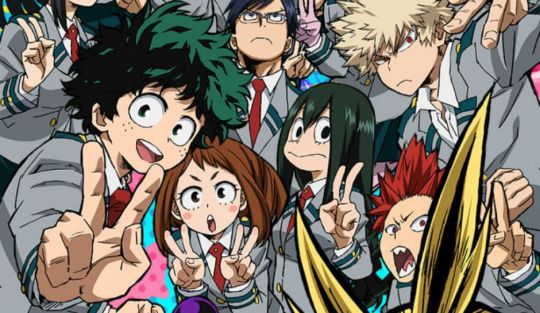
I found the first season of My Hero Academia to be pretty good but nothing to get excited about- but damn, this season officially sucked me in. I am now a Fan. Very unwillingly, I might add, but the show wrestled my doubting heart into submission with its endearing characters. fight-y fun and surprisingly good handling of growth and relationships (for the most part).
The basic concept behind My Hero Academia is that in a world where most people have some form of superpower, superheroism is considered a legit profession. Nerdy teenager Izuku Midoriya really wants to be a hero, but he’s one of the few people born without superpowers. However, when he encounters his idol, the number one hero All Might, everything changes and he soon finds himself enrolled in the top-ranked superhero academy.
MHA sparked my interest by being a superhero show (I’m a huge comics nerd) and kept me interested by having a legit adorable and sympathetic protagonist (Midoriya is very earnest and also cries a lot, both things I find intensely cute and relatable), good animation and generally solid fights and storytelling. But it wasn’t really until this season that it came into it’s own as an impressive ensemble show. It subverted quite a few expectations I had, in a really good way and delivered on some pretty incredible character work and interesting world building. Also, it has a great soundtrack.
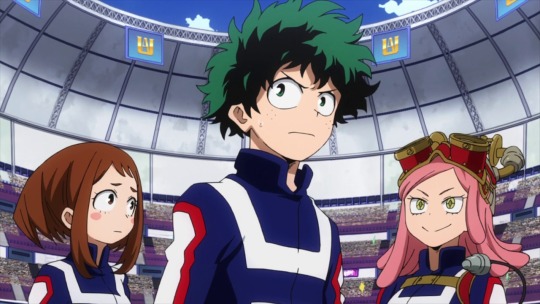
The season opened with a tournament arc, and I usually find those pretty boring in shonen (though still good, they were easily my least fave parts of HXH, for instance) but this one really mixed things up by weaving in some really good emotional hooks for the one-on-one fights and actually *gasp* developing characters and rivalries that WEREN’T focused on the protagonist.
Rather than going the safe and expected route of having a big match-up be between Midoriya and his intimidating, violent explosion-happy rival, the series showed us a fight between explosion dude and the adorable, sweet main female character (whose superpowers were NOT well-suited for fighting his explosions) and used it to showcase her determination even against incredible odds and further her story along.
It also explored her motive for being a hero- her family isn’t well off and she wants to make some serious cash so they can live in comfort. She worried this motive was “unheroic” but was reassured it was admirable, which was nice to see, especially considering how female characters are generally discouraged from being ambitious.
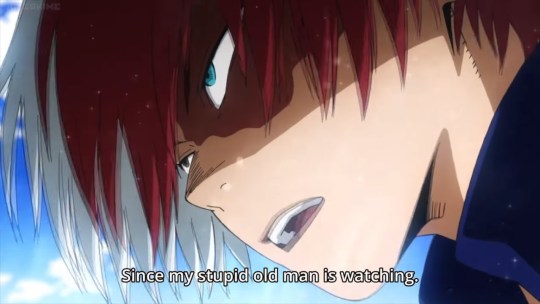
But the biggest highlight of the arc was the exploration of one character’s trauma and abuse. An arc revolved around a characrer (Todoroki Shouto) having difficulty using the powers he inherited from his abusive father. The story was heartbreaking and well-done and addressed in a very moving way with a very emotional “you are not your parents, it’s your power and body, not theirs” core- but what really impressed me was that the arc’s acknowledgement that this kid’s recovery would not be instantaneous and it was going to be a long and difficult process involving many other steps.
In most shows, once Todoroki had gotten his weird therapy session courtesy of the protagonist, Midoriya, and had been able to use his powers once, it would have been over, done, he’s fixed and he can totally use them now. But instead, the show acknowledged that being able to overcome his trauma enough to use them for a few minutes didn’t mean he’s now so recovered he can just use them whenever he wants. Todoroki realized that he had a lot of unresolved issues he needed to work through and a lot of steps he needed to take before he could recover enough to be truly comfortable with using his powers all the time. “It’s not that I’ve accepted anything, it’s just that, for a moment, I was able to forget about [my dad]”, as he put it. And the show showed us that it had every intention of following him through that recovery process.

Seeing this over-the-top show about superpowers and fights where people suffer ridiculous injuries actually approach trauma recovery in a realistic and nuanced way really shocked me and also majorly tugged by heartstrings. The whole conflict also added some depth to the show’s world building- Todoroki’s scumbag dad is one of the top superheroes out there, despite being a totally horrible person. When being a superhero is a competitive profession rather than a calling you get people who aren’t necessarily “good” or into “saving people” as much as they are in it to make a profit and show off their powers. Which went nicely with the themes of the arc that followed the tournament arc.
The way the show plays around with typical shonen tropes is also great- the show has the highly gifted, arrogant once-upon-a-time-they-were-friends rival for our main character, but he doesn’t become insufferable like most of those characters because the show makes fun of him constantly. None of the other characters put up with his bullshit or take him seriously, he’s constantly called out and made fun of for his asshole attitude and the main character finds him genuinely unpleasant to be around and tried to avoid him socially. This allows his ANGRY EDGELORD nature to be funny rather than annoying, because the show’s in on it too.
And while Todoroki also could have also been a brooding asshole rival character, he’s pretty quickly to be revealed as a nice, kinda dorky guy who’s just quiet, awkward and introverted due to trauma and lack of social interaction. The show’s really self aware in how if plays with these character archetypes for the most part, and that makes it a pleasure to watch.
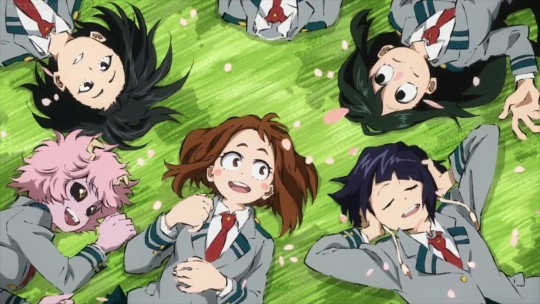
The show continued its solid character work, punctuated by dramatic and well done fight scenes, through the next arc. Almost every single kid on the show got a moment to shine this season, and you got to know them as characters and heroes and I came to realize- hey, I REALLY LIKE most of these characters.They’re being developed in a fun and interesting way, and they have lives and motivations that don’t just revolve around the main character. And the relationships and dynamics between the various characters are fun and heartwarming too.
And this includes the girls, who, while definitely outnumbered by the boys and underutilized compared to them, are really competent, interesting and have some great moments and arcs going. I especially enjoyed the mini-arc where one of the girls lost confidence in her ability to lead and thought a dude would be better at it, only for him to assure her she’s way better suited for it than him. Always nice to see ladies in command being respected by the dudes with them.
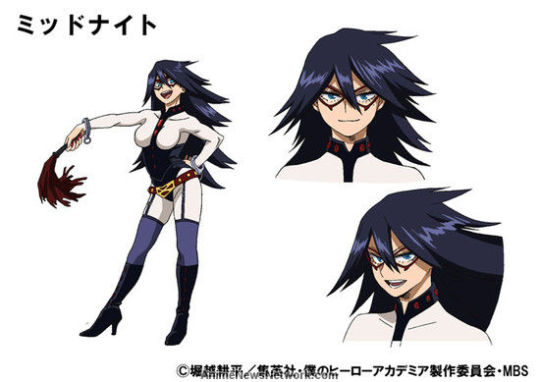
But that does bring us to the fact that while it has some good female characters, the show also has some pretty big sexism issues. All the older female heroes we’ve seen so far are basically walking sex jokes/fanservice dispensers and even some of the younger female characters are uncomfortably sexualized (Momo’s got the classic “oh she has to wear a ridiculously impractical costume because her powers require it” aka “I gave this teenage female character these powers specifically so I could sexualize her”). The fanservice gets to the point of distracting from the plot at times.
There’s a huge absence of female mentors so far (I hear that gets better later) and out of the entire teaching staff of the school, only one is a woman (and her character boils down to “bondage joke”) What’s more, while the girls are good fighters, their powers tend to be less offensive and "powerful” than the boys (this is especially obvs if you look at their official stats). Oh and there’s this fucker:
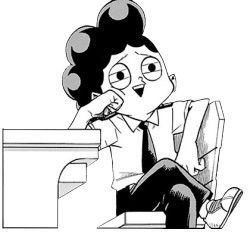
...who routinely sexually harasses and assaults his female classmates and it’s supposed to be funny and harmless. Every single time this asshole comes on screen u have to put up with a deluge of gross-ass comments and seeing the female characters repeatedly be objectified and have their space invaded. And no, them hitting him or other characters saying it’s gross does not make it okay. It’s still allowed, it’s still clearly there to be “funny” and “titillating” and it still uses girls being abused as a “fun” interlude. That’s NOT okay. It’s not funny. He adds nothing to the show, he just grinds everything to a halt and makes everything uncomfortable. It’s jarring, and takes you out of an otherwise well done story. I really want him and this type of “humor” to be ejected from the show.
But yeah, with those major issues in mind (and god I wish they weren’t there), I still really enjoyed MHA and can’t wait until the next season. The plot’s ramping up and I can’t wait to see where it goes next.
KiraKira Precure a la Mode
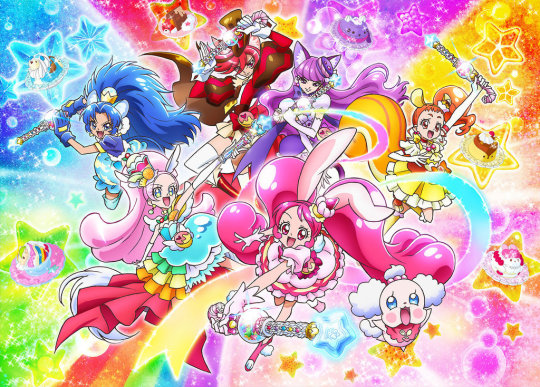
Kira Kira Precura a La Mode follows a group of magical girls with superpowers based on both sweets and animals. They run a pastry shop together and protect their city from monsters who want to suck the energy of people who are happily enjoying their favorite confections.
Okay, this is still ongoing, but I think it’s safe for me to say at this point that KiraKira is well on its way to being one of my favorite Precure shows, which considering how I’m a pretty big Precure fan, says a lot.
The writing is solid, the characters are fun and well-developed and the animation and art design is well-done and adorable.

This season added a few fun new touches to the Precure formula, including having two older girls on the team- a pair of 17 year olds hanging with the 14 yr olds (14 is the typical age for Precure protagonists). This pair is a butch and femme couple pretty clearly patterned after Haruka and Michiru- and yes, that also means they are fairly blatantly a lesbian couple.
There is in fact an entire episode revolving around Yukari (femme cat magical girl) trying to make Akira (butch dog magical girl) jealous by threatening to marry a prince and making Akira compete with him for her love. All the while, Akira struggles with whether she should share her true feelings with Yukari. This culminates in a big love confession scene that added ten years to my life. Seeing the younger girls aggressively encourage and support their relationship is great too.

So yeah, about as blatant as S-season Haruka and Michiru- which, if you understand that reference, means there ARE some scenes that try to cast ambiguity on the relationship. This one, for instance, where Akira acts flustered in response to the prince’s suppositions about her relationship with Yukari (and his incorrect assumption about her gender), makes sense in the context of a just forming relationship, but also didn’t add much to show and was likely included so the show could make it seem ambiguous if Yukari and Akira will truly enter a relationship.
However, it has been a long time since we’ve gotten lesbians this blatant in a magical girl show aimed at young girls. Ever since the days of Cardcaptor Sakura and Sailor Moon, gay subtext and text in magical girl shows has been much lighter (and heck, even fanservicey aimed-at-guys magical girl shows don’t seem to have the guts to have girls kiss).

So the fact Precure is now deliberately homaging and emulating Haruka and Michiru and doing blatant love triangle/confession scenes IS a big deal and a step in the right direction. It’s sad we haven’t progressed since the days of Sailor Moon, but it’s good we’re at least not regressing anymore. And while Akira and Yukari haven’t gotten the word of god “Yes they are lesbians” confirmation Naoko Takeuchi gave Haruka and Michiru, (at least, not any we’ve heard of in the West), I wouldn’t say it’s outside the realm of possibility that could happen. (I really doubt the “lol we’re having sex” lines similar to what we got in Sailor Moon Stars will happen though, just because Precure doesn’t do sexual innuendo).
And it’s worth mentioning, we do have an official duet song for Yukari and Akira that’s VERY blatantly romantic. “Koi” is even in the title.
Yukari and Akira are a censored relationship for sure, and it’s obnoxious and wrong those censors are still in place (though not surprising, considering this is a big corporate studio running Precure). They should be able to kiss, they should be openly dating. However, they are obvious enough that if they were a straight couple, we’d be calling them canon at this point, so I’m gonna. Also, I have to shout out that they’ve poured on Utena references GALORE with these two, and I’m super into that.
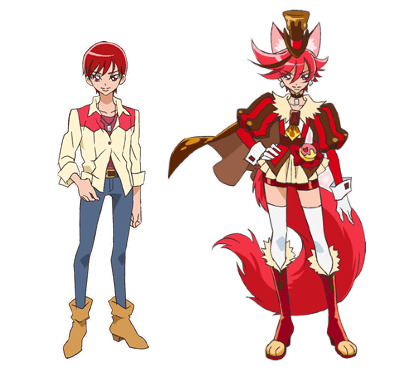
It should also be noted that Akira is allowed to maintain her butchness even after transforming into a magical girl- she gets a frilly PRINCE outfit. That’s a first for a magical girl show aimed at girls (unless you count Utena, which I don’t for various reasons). She’s never derided for her lack of femininity either (in fact she’s considered cool and attractive) which is a very good affirming message for young girls. There’s also another episode that frames rebellion against enforced traditional femininity as a good thing and has women standing up for and supporting other women who don’t follow gender roles.
To state the obvious, Precure is a show that exists in a capitalist society. So it’s focused on selling toys to little girls and those toys are often stereotypically hyper-feminine. However, it’s still valuable and positive that this show is casting non-gender conforming heroes in a positive light- if a little girl wants to play as Akira, she might have a pink compact, but she can use it to become a dashing butch prince. The lines are blurring in a good way.
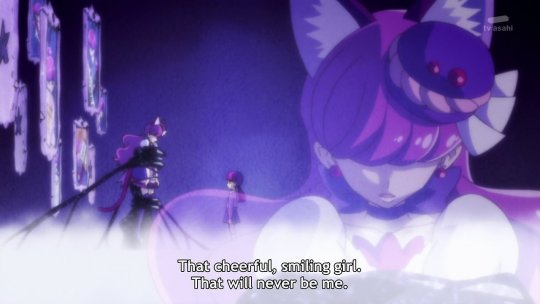
Yukari is also notable as a great character- she’s not the genki girl archetype, but messy, petty and a bit cynical. She’s complex. The episodes where she struggles with whether she’s a “good girl” are pretty inspiring and carry the message girls can be heroes even if they’re not all sunshine and daisies.
In fact, all the characters in the season are ALL pretty solid. Their relationships are fleshed out and so are their arcs. The dynamic the whole team has is great. The villains redemption arcs are strong as well. And as always, it’s cute as heck and bursting with lady friendship feels.
My biggest problem with this show would be pacing- it suffers from being two rushed a lot of the time, and often tries to cram way too much in one episode rather than giving conflicts and arcs room to breathe. But that’s my only big issue.
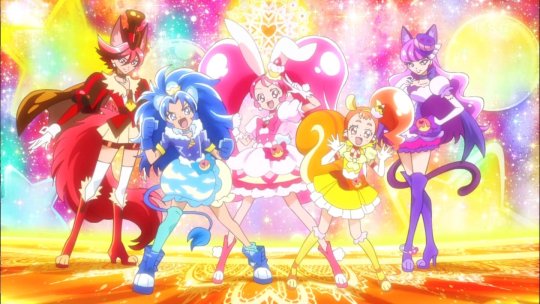
It’s possible KiraPre could have a disappointing finale, but I at least feel confident it won’t end in total disaster. It shows none of the warning signs shows like Hachepre did- there’ve been no love triangles, bland male love interests or anything of the sort shoehorned in, so I don’t feel I have to worry about the worst happening (the “worst” being “the finale revolves around soothing a dude’s wounded ego, with the bond between the magical girls and their power being sidelined for the sake of really uncomfortable and contrived het romance”, if you haven’t seen HachaPre).
Let’s hope KiraPre’s finish is as strong as the rest of it has been!
#my hero academia#kirakira precure a la mode#kira kira precure a la mode#anime overview#summer 2017 anime
52 notes
·
View notes
Text
Trials of Mana Review — Class Changing Into a Brand New Form
April 22, 2020 11:00 AM EST
Despite a few hiccups along the way, Trials of Mana is a worthy remake of the original and also serves as a great entry point for new fans.
Seiken Densetsu 3 first made its appearance in 1995 for the Super Famicom but unfortunately, the game would never receive a Western release in its original form. Now, under the new name Trials of Mana, the game has finally arrived outside of Japan as a full 3D remake of Seiken Densetsu 3. Everything from the monsters, towns, gameplay, dungeons, and character models have been lovingly translated from the original 2D title.
And while this may be a solid entry in the Mana series, it begs the question of whether this can be considered a solid JRPG in its own right.
youtube
Trials of Mana follows a pretty standard fantasy plot that revolves around a diverse cast of JRPG archetypes as they save their respective kingdoms and the world from evil forces that are attempting to activate the Mana Stones and gain the power of the Mana Sword. Along the way, these characters aid the elementals that represent each stone and gain their alliance in return.
Although the story could have easily been annoyingly cliched and boring, there’s something about having such a straightforward plot with characters who are clear cut and consistent in their motives and behaviors. It’s charming almost and a refreshing change from the more convoluted plots that tend to drag down other narrative-heavy titles.
“Everything from the monsters, towns, gameplay, dungeons, and character models have been lovingly translated from the original 2D title.”
The real draw of Trials of Mana, however, is how the story and antagonist changes depending on the protagonist you choose at the start. Two characters share one villain though between them there may be vast differences in their narrative arcs. For instance, Duran and Angela have the same foe, the Crimson Wizard, but the reasons for why they oppose this baddie comes from opposite starting points.
Depending on what two party members you choose also affects how the overall story unfolds. A good example is my own party composition: thanks to how events unfold in-game, Riesz’s resolution with her kingdom, Laurent, occurred fairly early, while Kevin must wait until later chapters before his main plot is addressed. This also meant that due to Angela being the leading lady in my playthrough, Duran took a more passive role when Valsena’s liberation comes into play.
Even now, this kind of storytelling style is a rare find but it’s even more surprising when you consider that the original Seiken Densetsu 3 was made in 1995. Playing through Trials of Mana, I found myself amazed at how much dialogue variety there is since the scriptwriters had to predict every conceivable scenario for the player’s party composition. It’s not a perfect system, as sometimes story beats can be a bit awkward as they show their age, but it’s an extensive one that adds an incredible level of replayability to the game.
The gameplay in Trials of Mana is an absolute blast as the 2D combat from the original translates well to the 3D plane as characters move, attack, and dodge smoothly. You have a variety of basic moves–attacks, power strikes, and charge attacks –as well as Clash Strikes, which are denoted by a special double gauge called the CS gauge.
Despite the palette swapping and slight model changing of most enemy “families,” each type has a distinctive moveset, pattern of attack, and unique abilities. For instance, there are several foes that evolve into a stronger form mid-battle when a certain condition is fulfilled. The changing strategies among foes forces you to re-examine and modify your own strategy. It’s a constantly shifting environment that prevents you from getting too complacent, which makes for thrilling battles.
Bosses are no slouch, either. The first two or so are lightweights that merely test how well you’ve mastered the combat mechanics. After this point, the game takes off the proverbial kid gloves and proceeds to pound you into the dirt if you haven’t been allocating your training points, are too low level, aren’t paying attention to AOE moves, or haven’t taken advantage of class upgrades.
There are plenty of hiccups in combat, though. The camera, as in many action and action RPG titles, can be your worst enemy at times. Most of the time, it’s easy enough to adjust on the fly and enemies won’t punish you for not having them in your sights at all times. But when it gets stuck on corners or in tight corridors, wrestling back control while maintaining a steady assault becomes an exercise in patience that I didn’t consent to. There’s also the inconsistent nature of the targeting system, which can make the camera go haywire at times and will de-lock at random intervals.
“The gameplay in Trials of Mana is an absolute blast as the 2D combat from the original translates well to the 3D plane.”
The AI for party members can be hit or miss as well. AI is generally smart enough to dodge most AOE attacks, target foes with moves that make sense (ie: using aerial attacks on aerial enemies), and overall do well at abiding by the AI behavior you set for them. And if you set the proper behaviors, your supports and healers will reliably use the corresponding spells and abilities.
However, they tend to have trouble with more complex behaviors such as avoiding very precise AOE moves or any sort of damage from normal attacks. It’s frustrating to say the least when party members fall prey to easily avoidable attacks and you’re forced to pick up the slack. This is compounded even more so if, like me, you have no white mage in your party and rely on your limited supply of items.
These shortcomings do very little to take away from both my overall enjoyment of combat and from my favorite part of Trials of Mana: the dungeons. While nothing is wrong with the more linear experience of modern JRPGs such as Final Fantasy VII Remake or Persona 5 Royal, I missed the more sprawling dungeon maps of classic titles. Fortunately, Trials of Mana completely delivers on that front.
Each area is set up with a unique gimmick that serves as the key to navigating. But as players will soon notice, there are tons of alternate pathways filled with hidden secrets and valuable treasures; completely optional but well worth your time to fully explore them. There’s also a Lil’ Cactus (which is literally a cute and tiny cactus, a franchise staple NPC) hidden in nearly every dungeon and town, and finding a certain amount of them grants you useful effects such as shop discounts, occasional double experience points post-battle, and more. Having the option to go nearly everywhere in a given dungeon is refreshing and reminds me of some of the best aspects of old school JRPGs.
As the party defeats enemies and levels up they begin to earn training points. These training points can be allocated to abilities and stat increases that correspond with the five categories: stamina, strength, intelligence, luck, and spirit. Naturally, characters have leanings depending on their class specialties. Trials of Mana does well in incentivizing the allocation of points to every category regardless of their perceived relevance by ensuring useful abilities and stat gains.
After a certain point in the game, Mana Stones grant the party the ability to class change. Each character can choose between Light and Dark paths, which determine future abilities they’ll have access to as well as how their stats will grow. The training points and the class system is simple but offers some nice options; even within the restrictions of each class, there are many ways to customize your allies depending on your playstyle.
Despite Trials of Mana being a remake of a mid-90s Super Famicom title, this game unabashedly takes its cues from early 2000s JRPGs. From the bright and colorful visuals, to the simple story, to the more experimental free-movement action combat style that started to emerge in that era to even the voice work, Mana is entrenched in bizarrely misplaced nostalgia. And yet its presentation works almost entirely in its favor, as it allows Mana to stand out from the crowd of super-stylized or hyper-realistic titles, much like how Xenoblade Chronicles 2 did so when it released in 2017.
The visuals absolutely shine as a result of this design choice, as they manage to balance simple designs and vibrant colors with genuinely stunning and detailed environments. Every time I enter a new area, I look forward to seeing how they’ll interpret its original 2D look into the new (yet retro) graphics.
Even better than the graphics is the soundtrack which is brimming with fantastic remixes. One of my favorites is the boss theme which blares as Full Metal Hugger emerges from the cave. The rest of the soundtrack is just as phenomenal, ranging from energetic battle theme chords to upbeat town melodies to the solemn music featured during more dire straits. Fans of the original Seiken Densetsu 3 are sure to be pleased by the amount of care and effort that has been put into this OST.
“Trials of Mana is an easy recommendation to both fans of the franchise as well as newcomers looking for an entry point into the series.”
Conversely, the voice acting is where this stylistic choice suffers the most. Voice acting, which was a new frontier for many developers in the early 2000s, isn’t spectacular here, either. The English voice work is extremely inconsistent, as some actors sound quite comfortable in their roles while others flounder to summon any sort of consistent character voice and emotion. Don’t think you’ll avoid this issue by switching to Japanese either, as the voice acting is just as mediocre. If voice acting quality is a major concern for you, this could have a huge impact on your experience. As for myself, I found the voice work growing on me as I played through the game to the point where I honestly forgot how awkward it was.
Though not a perfect game, Trials of Mana is still a solid remake of a 2D classic that tragically never made it to the West until now. With a fun and strategic battle system, ample character class customization, impressive visuals, a fantastic soundtrack, and a post-game story episode with new classes for each playable character, Trials of Mana is an easy recommendation to both fans of the franchise as well as newcomers looking for an entry point into the series.
April 22, 2020 11:00 AM EST
from EnterGamingXP https://entergamingxp.com/2020/04/trials-of-mana-review-class-changing-into-a-brand-new-form/?utm_source=rss&utm_medium=rss&utm_campaign=trials-of-mana-review-class-changing-into-a-brand-new-form
0 notes
Text
Royal Rumble 2017: Thoughts and Predictions
Not gonna beat around the bush; this Rumble is unpredictable as hell. The fact that they took Seth Rollins off the title hunt and is now putting him in a program with HHH means we’re looking at at least 5 possible winners.
Here’s my list, in no particular order:
1) Braun Strowman
- He’s big, he’s meaty and he’s become quite the popular lad lately, thanks in part to his pretty great booking as a squash monster, and a series of pretty great matches against another entry on this list.
- Will he win it: I’m going to go with a soft “Not this year”. Yes, WWE has shown its preference for big hulking specimens in the past, but the new hero archetype they have these days is pretty easy to decipher; they want someone tough, badass, who’s not only an unstoppable physical specimen but also a catchphrase generator and merchandise mover. What they’re doing is taking a look at two of their most successful modern male babyfaces, The Rock and John Cena, and creating a new superstar from the ground up. Braun Strowman as of this moment, is very definitively a heel, and the last thing Raw needs is more male heels.
- What’s he going to do in the RR: He’’s going to decimate each and every one he comes across, but he’s going to go down courtesy of Brock Lesnar and Goldberg putting aside their differences, before the next person on this list kicks him and eliminates him.
2) Sami Zayn
- Oh Sami, what the fuck have they been doing to you? He’s a modern indie hero who everyone thought was going to get the push he deserved after Battleground 2016. Although, looking at how they’re booking KO right now, I’m not too sure what they would’ve done with Sami in the title picture.
- Will he win it: While it would be a great notch on his underdog belt, I’m going for a definitive “NOPE.” Sami’s still allegedly getting backstage heat; not exactly news to people who have said that Rami Sebei can be a little too vocal with his passion for wrestling and wants things, from matches to his character work, a certain way. He wants matches to be as good as possible, and the thing is he’s usually right -- he has an immense wrestling IQ and puts subtle nuances into his actions and reactions that can be used to argue that wrestling is in-fact high-art. Add to the fact that his character is a little too smiley, a little too goofy, a geek who’s “just happy to be there” -- it’s about as far away from what WWE are looking for in a main-eventer. And before anyone brings up D-Bry, it’s well known that the audience basically had to riot before anyone in WWE would listen. Sami, as good as he still is, just isn’t getting the same reaction from the crowd anymore.
- What he’s going to do in the RR: While him winning it would be a stretch, I expect him to get some form of revenge against Braun Strowman, likely being the one to eliminate him, with some help from Goldberg or Brock, maybe even Undertaker. What would also be a great way to keep him underdog-y without making him a loser is to make him the Iron Man of the Rumble; have him enter at #1 or #2 because he got on Steph’s nerves or something, but have him be in the final 5.
3) Samoa Joe
- If they do decide to bring the Samoan Submission Machine into the main roster, the Royal Rumble would be a great way to introduce him to mainstream WWE audiences. Joe is such a goldmine for new storylines; pit him against Brock, let him exchange blows with Goldberg.
Personally? I’d love for him to go against Roman Reigns. They need to book Joe like an unstoppable killing machine, going up against another unstoppable killing machine like Reigns. Also, I kinda want to know what happens when a Samoan headbutts another Samoan.
- Will he win it: This is entirely possible, especially if they decide to give Roman the UC title; a triple threat between Reigns, Joe and Owens (who, by this time, has reverted to NXT-era Owens)? Yes please.
- What he’s going to do in the RR: Joe is gonna kill you.....Joe is gonna kill you....Joe is gonna kill you.....to pretty much everyone, except maybe Brock, Goldberg and Undertaker. That, actually, would be the perfect time for Joe to make his entrance. Imagine Brock, Goldberg and Taker, all sharing the ring, the audience going nuts as they re-enact their last face-off on Raw. All considered dominant juggernauts....who didn’t consider the other juggernaut who’s now making his way to the ring. Samoa Joe makes his entrance, but he doesn’t run to the ring, taking his time. He gets in and all 3 men hesitate. This isn’t just some random entrant -- he’s an actual, legitimate threat, even to them.
4) Chris Jericho
- Assuming his prediction comes true, Y2J may have one more chance at a world (or Universal) title reign. Story-wise, this could be the catalyst for the eventual dissolution of his friendship with Kevin Owens
- Will he win it: Surprisingly a great chance of this actually happening. Chris is a loyal, trusted employee and is one half of the most entertaining duo on Raw (sorry Enzo and Cass). He’s over as hell, very experienced and quite safe to work with. The man, along with Owens, is gold on the mic, no matter what stupid shit they force him to say; he says it with such conviction and commitment that it’s magical.
- What he’s going to do in the RR: Chris will use his considerable experience, teaming up with whoever; heels, faces, tweeners -- Jericho will try to make alliances with everyone to try and eliminate as many people as possible at once.
5) Finn Balor
- This one is such a difficult one to predict. Is he going to return? Is he cleared to compete? If he does return, how are they going to insert him into the storyline they created in his absence? Finn’s return will be a game changer; remember this was a guy who beat Roman Reigns on his first try when Seth and Dean, both of whom fought alongside/with Roman and knew him inside and out couldn’t beat him despite multiple attempts. That is how much WWE is putting on Finn Balor and its frankly both terrifying and amazing.
- Will he win it: If Balor returns, he’s 100% going to win, there’s no doubt about it. Every single one of the people on this list is fucked if Balor returns. This is a guy who the WWE likes and, very importantly, the audience also likes. He has accolades around the world, matched only by AJ Styles and Shinsuke Nakamura (who’s also a candidate to win) and this seemed to be enough for WWE to move on from Roman as a pet project, which speaks volumes.
- What he’s going to do in the RR: If he returns as Demon King, like I said, everyone’s basically fucked. Dropkicks and slingblades galore. He’s going to be facing some very, very well-protected people like Brock, Goldberg and Taker, but let’s all remember that this guy beat ROMAN REIGNS ON HIS FIRST TRY. That is about as OP as you can get without bringing a fucking gun to the Rumble.
Whew. That’s the end of that. There’s actually a few more who could plausibly win this Rumble, but the five I listed, I think, are the most likely candidates for success. Thoughts, opinions, civil discussions welcome! We’re just a few hours away!
#wwe royal rumble#braun strowman#sami zayn#samoa joe#chris jericho#finn balor#predictions#thoughts#2017 royal rumble#wrestling#mithen#mitchtheficus#apgeeksout
0 notes